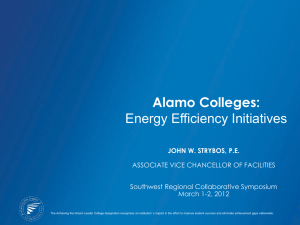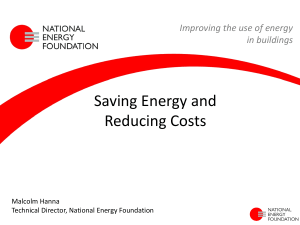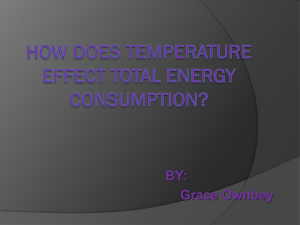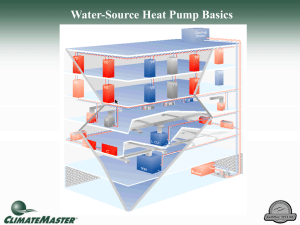Heat balance method
advertisement
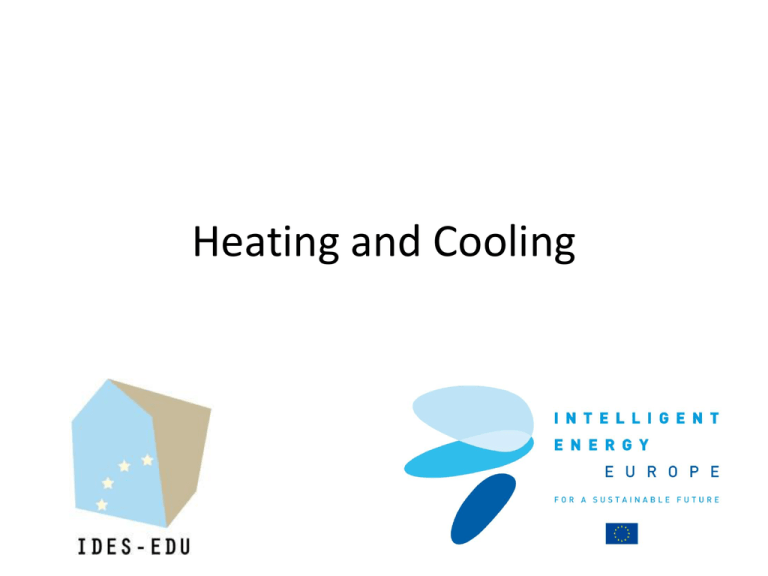
Heating and Cooling • • Coordinator: Karel Kabele, kabele@fsv.cvut.cz, CTU in Prague • • • Contributors: Eric Willems, Erwin Roijen, Peter Op 't Veld, P.OpTVeld@chri.nl Camilla Brunsgaard, cbru@create.aau.dk & Mary-Ann Knudstrup, mak@create.aau.dk, Aalborg University, Per Kvols Heiselberg, ph@civil.aau.dk, Tine S. Larsen, Olena K. Larsen, Rasmus Lund Jensen (AAU) Arturas Kaklauskas, Arturas.kaklauskas@st.vgtu.lt, Audrius Banaitis, Audrius.banaitis@vgtu.lt , Vilnius Geniminas Technical University (VGTU) Marco Perino, marco.perino@polito.it, Gianvi Fracastoro, Stefano Corgnati, Valentina Serra (POLITO) Werner Stutterecker, werner.stutterecker@fh-burgenland.at, (FH-B) Mattheos Santamouris, msantam@phys.uoa.gr, Margarita Asimakopoulos, Marina Laskari, marlaskari@googlemail.com, (NKUA) Zoltan Magyar, zmagyar@invitel.hu, Mihaly Baumann, Aniko Vigh, idesedu.pte@gmail.com (PTE) Manuela Almeida, malmeida@civil.uminho.pt, Sandra Silva, sms@civil.uminho.pt , Ricardo Mateus, ricardomateus@civil.uminho.pt, University of Minho (UMINHO) Piotr Bartkiewicz, piotr.bartkiewicz@is.pw.edu.pl, Piotr Narowski, piotr.narowski@is.pw.edu.pl (WUT) Matthias Haase, matthias.Haase@sintef.no, (NTNU) Karel Kabele, kabele@fsv.cvut.cz, Pavla Dvořáková, pavla.dvorakova@fsv.cvut.cz, (CTU – FCE) • • • • • • • • • DESIGN AND ANALYSIS TOOLS Heating system calculation tools IMI top Calculation tools • • • • Edit speed List of material Detailed properties Graphic interface Calculation tools One pipe system calculation MODELING AND SIMULATION Virtual models F ig. 3 . E S P -r m o d el o f th e bu ilding Reality Real size models Scaled models Modelling and simulation tools clasification System Integrated Scope Forward Steady state Method Building performance Data modelling & simulation Data - Driven Dynamic Environment Energy Purpose Sustainability Comfort Tools overview http://www.eere.energy.gov/buildings/tools_directory/ http://www.ibpsa.org Building Energy Performance Simulation ESP-R ESP-r background • • • • • • ESP-r (Environmental Systems Performance; r for "research„) Dynamic, whole building simulation finite volume, finite difference sw based on heat balance method. Academic, research / non commercial Developed at ESRU, Dept.of Mech. Eng. University of Strathclyde, Glasgow, UK by prof. Joseph Clarke and his team since 1974 ESP-r is released under the terms of the GNU General Public License. It can be used for commercial or noncommercial work subject to the terms of this open source licence agreement. UNIX, Cygwin, Windows http://www.esru.strath.ac.uk/ ESP-r architecture Project Databases maintenace Climate Material manager Model editor Zones Construction Plant components Event profiles Optical properties Networks •Plant •Vent/Hydro •Electrical •Contaminant s Controls Simulation controler •Timestep •Save level •From -To •Results file dir •Monitor •… Results analysis •Graphs •Timestep rep. •Enquire about •Plant results •IEQ •Electrical •CFD •Sensitivity •IPV Case study 1 USE OF ESP-R FOR EVALUATION OF RADIANT HEATING/COOLING SYSTEM WITH CAPILLARY MATS PROBLEM DESCRIPTION • The main purpose of this study was to investigate integrated heating/cooling system performance during typical Central Europe climate conditions with office operation load profile. – Is the integrated ceiling heating/cooling system able to secure compliance with comfort requirements during the whole year operation? – Are the existing design recommendations in terms of maximum heating/cooling output of the ceiling applicable particularly in climate conditions of Central Europe? Integrated heating/cooling ceiling system with capillary mats PROBLEM ANALYSIS We focused on three types of the buildings, where integrated heating/cooling ceiling system has been used and problems appeared. – residential building – office building with small offices – office building with open space offices PROBLEM ANALYSIS At first a list of parameters, that may have any influence on the possibility of the integrated ceiling heating/cooling system application was created. The list contains following parameters: Internal sensible heat load Internal latent heat load Infiltration air rate Ventilation air rate Humidity control Quality of the walls - U value Glazing ratio Quality of the windows – U,g value Active shading – blinds Ratio of hight to depth of the room Orientation Set point for heating Set point for cooling RESEARCH METHOD ESP-r simulation of an annual building energy performance, 1 hour time step Active Ceiling / Floor constructi Flooring Polyurethane foam board A five - zone model in ESP-r Glazing 3o% of one outside wall each zone Medium-heavy constructions external wall U = 0.24 W/m2K internal wall U = 1.56 W/m2K window U = 1.20 W/m2K, trn=0,76 Heavy mix concrete Gypsum plaster with capillary mats System is defined by heating capacity controlled according to established practice in a range of 0-130 W/m2, cooling capacity 0-80 W/m2 in each of the rooms. Set point for cooling is 26°C, for heating is 22°C. Model was loaded by • Czech climate conditions (IWEC) Total internal load [W] Model operation profiles 5000 4500 4000 3500 3000 2500 2000 1500 1000 500 0 Mo Tue Wed Thurs Qsens,pers Fri Qsens,lights Sat Sun Qsens,equip Total internal load [W] Residential – B1 10000 9000 8000 7000 6000 5000 4000 3000 2000 1000 0 Mo Tue Wed Qsens,pers Thurs Fri Qsens,lights [W] Sat Sun Q sens,equip [W] 3 alternatives of operation schedules • occupants (sensible,latent load) • lights • equipment Total internal load [W] Small office – K1 10000 9000 8000 7000 6000 5000 4000 3000 2000 1000 0 Mo Tue Wed Qsens,pers [W] Thurs Fri Qsens,lights [W] Sat Sun Q sens,equip [W] Open space office – VK1 SIMULATION RESULTS CRITERION annual heating/cooling energy use comfort expressed by resultant temperatures, PMV and PPD parameters the possibility of condensation on the ceiling surface during the cooling period Alternative Heating [kWh/m2/a] Cooling [kWh/m2/a] Residential 45.3 69.3 Office 7.4 228.4 Open-space office 7.2 264.9 SIMULATION RESULTS CRITERION annual heating/cooling energy use comfort expressed by resultant temperatures, PMV and PPD parameters the possibility of condensation on the ceiling surface during the cooling period Residential – B1 Small office – K1 Open space office – ? Resultant temperature x db temperature ? Weekends - Peak values SIMULATION RESULTS CRITERION annual heating/cooling energy use comfort expressed by resultant temperatures, PMV and PPD parameters the possibility of condensation on the ceiling surface during the cooling period Residential – B1 Small office – K1 Open space office – SIMULATION RESULTS CRITERION annual heating/cooling energy use comfort expressed by resultant temperatures, PMV and PPD parameters the possibility of condensation on the ceiling surface during the cooling period Residential – B1 Small office – K1 Open space office – CONCLUSION • The simulation shows that common design heating/cooling capacities (130 and 80 W/m2) of the ceiling surface are appropriate for all three simulated cases. • The system can reliably guarantee the required temperature during the whole year in the heating mode. • Several problems are detected with the cooling, when the designed capacity cannot cover the temperature requirements and occasionally a short-term condensation can occur. • The application of this integrated system is limited by its capacity. especially in the buildings with higher internal gains and connected cooling demand this application is disputable. Building Energy Performance Simulation Tools IES,TRNSYS, IDA, ENERGY+ TRNSYS Lawrence-Berkeley National Laboratory (USA) Simulation buildings and energy systems User-friendly interface Elements library Commercial product IDA Nordic tool (Sweden) Modeling and simulation of Buildings and systems Databases Standard climate data files Commercial tool Design Builder ( Energy+) US /UK tool Modeling and simulation of buildings (and systems) Different levels of model detail 3D realistic model Commercial tool/ free calculation kernel IEQ simulation - CFD FLOVENT,FLUENT… Computational Fluid Dynamics • Modeling of indoor environment - air flow patterns, temperature distribution, polutantat concentration – – – – – Aerodynamics of interior or exterior Navier- Stokes equations Temperature, pressure, air flow velocity and direction, radiatin Convergence calculation – turbulent fows, symetry, sensitivity Tools: Fluent, Flovent,ESP-r… Basic principle of modelling and simulation approach • Problem analysis – identification of the zones, systems,plant components and their dependencies • Assignment definition • Boundary condition definition • Definition of detail scale and model range • Proper tool selection • Sensitivity analysis • Results validation „Virtual laboratory is not design tool, but it can support design process …“ When to use simulation in building energy performance analysis? • Early phase of building conceptual design to predict energy performance of the alternative solutions to support designer decision process (building shape, initial facade and shading, HVAC concept) • Modeling non-standard building elements and systems (double-facade, atrium, natural ventilation, renewables, solar technologies, integrated HVAC systems) • Investigation of the operational breakdowns and set-up of control systems (HVAC, adaptive control, self-learning systems,…) • Indoor environment quality prediction (temperatures, air flow patterns, PMV,PPD) • Analysis of energy saving measures to energy use

